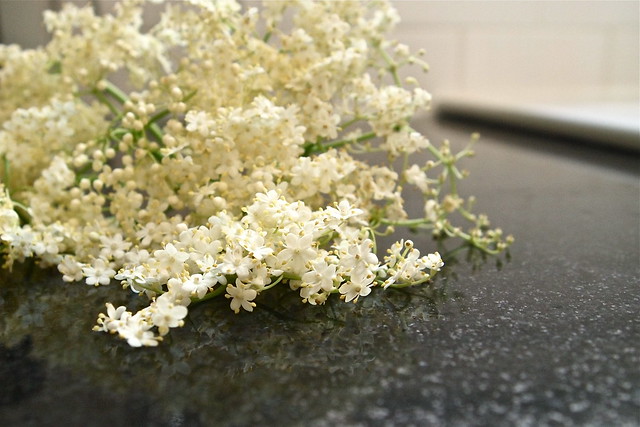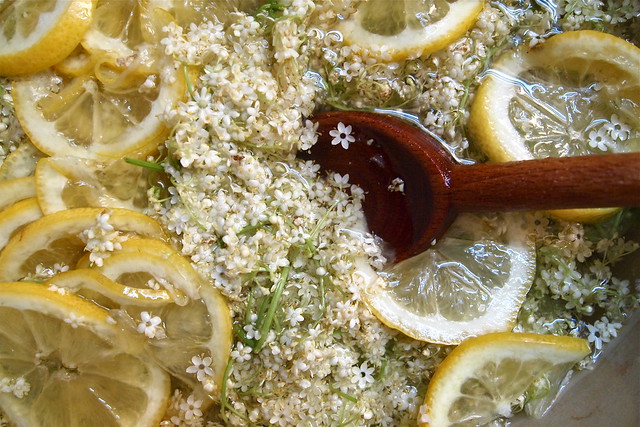Awhile ago, I finally picked up Luisa Weiss' memoir, My Berlin Kitchen. And, friends, if you don't already know firsthand, it is lovely through and through. Most of us at some point, I think, find ourselves struggling to figure out where it is we really belong, and Luisa gives clear and heartfelt expression to this in telling her story--the pull of your roots, your history can be hard, but it takes serious courage to leave one life for another, to really listen to yourself for once.
The bits of the book that I like best are by far the ones that take place in Berlin. These for the most part are little vignettes of everyday life--birthday parties, dinners with old friends, summer picnics--but they sparkle in a certain way. You can really tell that this is where Luisa feels most at home. And you get glimpses of Berlin that you can't just by visiting. I was there for a bit last summer and tried to take in as much as I could. I walked and walked and ate and ate, and though I loved almost every bit of it, I never really felt as though I quite got what Berlin was about. And maybe it's just that I wasn't there for long enough, that I didn't see quite enough of it, but my guess now is that what was missing from it all was a kitchen to cook in. You really get the sense from Luisa that Berlin's soul is in its kitchens, with its women and men tending to bubbling pots and deep bowls. How better, after all, could you get to know a city than by taking a trip to an overgrown orchard at its outskirts--probably given up during the Cold War--and picking plums for Pflaumenmus? Or by gathering up bunches of white asparagus at its markets and making sharp, bright salads? Or by snipping the sprays of elderflowers that bloom in its parks and bringing them home to make syrup? I can't really think of any.
In Chicago, you definitely can't expect to find elderflowers just anywhere. (And even if you do happen upon some in the city, I wouldn't advise cooking with them. Some of the soil around here is pretty seriously lead-laced. This NPR article on lead and urban gardening advises against eating roots and greens growing in contaminated soil but suggests that fruit and flowers might be safe to eat. Maybe you can just harvest elderflowers if you find them in your neighbourhood after all? I don't know. I'd have to do more research.) But Luisa's description of her first drink of elderflower syrup--a couple of fingers' worth poured in a glass filled with cold water, evocative of Berlin's spring and all that was missing in her life at the time--was enough to send me looking for some blooms around here. And I happened to be in luck. Elderflowers' short season in the Midwest falls between late June and early July. So, I was able to arrange with Seedling Farm to have some sprays ready for pick-up at the market. (The blooms are too delicate to survive much shuttling back and forth, so you have to contact the farm ahead of time.) Finding elderflowers is definitely the most troublesome part of making this syrup. The rest is just a matter of snipping the blooms from their stems and steeping them in a sugar syrup, along with a little lemon and citric acid. In a few days' time, the golden syrup is ready for bottling and drinking.
So far, my friends and I have been enjoying it mixed with sparkling water and lemon, sometimes a little good gin too. Yesterday, I tried adding a bit of muddled basil, which I quite liked. Luisa recommends a mix of Prosecco, muddled mint, sparkling water, and lemon. She also says that elderflower, while refreshing in the summer, is an entirely different thing in the dark of winter, that it really tastes of spring and even joy then. I am doing my best to save a little, but I can already tell that it's going to be hard.
Elderflower Syrup
From Luisa Weiss' My Berlin Kitchen
NOTE: You can find citric acid at Indian grocery stores, where it is labelled as "lemon salt" or "sour salt." As usual, I found mine at the Spice House.
UPDATE, 2013-12-09: A couple of months in, I noticed that my syrup had started fermenting a little. When I opened the bottle, there was a noticeable pop. I am not sure what to attribute this to. Perhaps I was not as thorough as I could have been with cleaning out my bottles. In any case, I didn't think too much of it until today when I opened my fridge to find that the fermentation had caused the glass bottle to explode (I hadn't opened it for awhile, and the bottle was stoppered with a wire-bail mechanism, so it was too secure to let any gas escape). Anyway, take this as a lesson--mind your fermentation.
UPDATE, 2013-12-09: A couple of months in, I noticed that my syrup had started fermenting a little. When I opened the bottle, there was a noticeable pop. I am not sure what to attribute this to. Perhaps I was not as thorough as I could have been with cleaning out my bottles. In any case, I didn't think too much of it until today when I opened my fridge to find that the fermentation had caused the glass bottle to explode (I hadn't opened it for awhile, and the bottle was stoppered with a wire-bail mechanism, so it was too secure to let any gas escape). Anyway, take this as a lesson--mind your fermentation.
20 to 25 large elderflower sprays
3 to 4 organic lemons, washed and sliced paper-thin, seeds removed
3 1/2 tablespoons citric acid
3 pounds and 6 ounces sugar
Clean and dry an opaque vessel large enough to hold about 5 quarts.
Hold each elderflower spray over the vessel and snip the tiny blossoms away from the stem and let them fall into the crock, taking care not to lose any of the pale yellow pollen. (Keep an eye out for tiny insects in among the blossoms. One or two are probably unavoidable. I found an itty bitty caterpillar. Shake them out or nudge them along towards the stem so that they don't end up in your syrup.) Add the sliced lemons to the vessel and sprinkle in the citric acid.
In a medium pot over medium heat, combine the sugar and 1 1/2 quarts of water. Stirring occasionally, melt the sugar and bring the mixture to a boil. Then remove it from heat and let the syrup sit until lukewarm.
Pour the syrup over the lemon and elderflowers and mix well. Cover the vessel with plastic wrap and let it stand in a cool corner of your home for 3 days, stirring once a day.
On the final day, uncover the crock and pour the liquid through a fine-mesh strainer into clean glass bottles. Discard the lemon slices and elderflowers. Store in the refrigerator or in a cool, dark cellar for up to a year.
Makes about 2 litres.





My sister used to work at the Spice House. I miss the care packages she sent to Boston from time to time. Sigh. I wish I was sipping an elderflower cocktail, and not behind a desk right now. :(
ReplyDeleteThose care packages must have been nice. If it's any comfort, I should (and hopefully will) be at my desk all day. I need to get this dissertation-ball rolling...
DeleteThank you thank you, for your kind words about the book, but especially for trying the recipe! I'm so glad you liked it. I didn't manage to make any this year (see: Hugo), but I'm already excited for next spring.
ReplyDeleteIt is wonderful stuff! Between the Fourth and a dinner we hosted on Saturday, we're down half a litre already. I kind of wish I'd made more!
DeleteAnd oh, I am looking forward to cooking more from the book! The Hannchen Jansen cake later this summer, if I can find some gooseberries or red currants at the market. And that roast goose...one day.
I also just finished reading this and loved it much like you did! You captured the essence of the book very well.
ReplyDeleteI am incredibly jealous you were able to make the syrup during the short season this year. Elderflower is my favorite favorite. I wish I could come steal some away from your pantry (ha!) - but then, there would be even less come winter. Must plan for next year!
I've just been particularly on top of things this year, at least when it comes to the growing season. It probably has a lot to do with having missed out on a lot (rhubarb, blueberries, raspberries) these past couple of years. I've been making an extra effort this year to get out to the bigger farmers' markets in the city, as far away as they are!
DeleteAs for elderflowers, you've got plenty of time to plan!
Sounds like a great book. And this is a lovely and special recipe. Glad you could arrange to get the elderflower. The pics are gorgeous. Found your blog through a mutual friend..Oana of dish chronicles. She mentioned you over dinner :-)
ReplyDeleteThanks for dropping by, Evelyne! And say "Hi!" to Oana for me the next time you see her. She's a swell lady! (By the way...what did she say about me?)
DeleteOh this is so cool! Your pantry is going to be awesome this winter, what with all the jams and preserved lemons and syrups you'll have. That is assuming all of this will last until then of course, haha. And I think it's nice how you read Luisa's book later than everyone else. It's a good reminder to me just because there were so many lovely summer and early fall dishes in her book that I kind of overlooked when I first read it. At that time, I think the pea soup and braised cabbage were more appropriate to me.
ReplyDeleteYeah, I'm trying to keep a little of everything to enjoy this winter. The current strategy is just to keep making preserves as new things come in season and hope that tastes of the new keep us from digging into our winter stores!
DeleteLuisa's book is definitely one to keep close year round. I'm going to have to keep an eye out for plums later this summer with that spiced plum butter in mind!
FYI, re lead-laced soil, you should definitely avoid eating roots and greens from plants grown in soil contaminated with lead, but flowers and fruit are much safer. Plants don't take lead up well (a few do: sunflowers, morning glories, some types of mustard), and when they do they tend to not get far. Keeping your soils on the alkaline side helps prevent lead uptake as well.
ReplyDeleteThanks for this, Shannon. Yeah, the NPR article I link does mention that. I only read it through fully after having written the relevant part of the post. I will update accordingly!
Delete